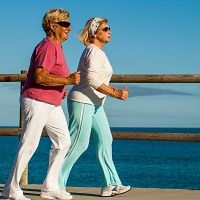Article
Evaluation of Severe COPD, Exercise, and Non-Invasive Ventilation
Author(s):
Chronic obstructive pulmonary disorder (COPD) accounts for eight million doctor visits each year in the United States alone, and a new analysis took a deeper look into adding multiple therapies to improve symptoms of the lung disease.

Chronic obstructive pulmonary disorder (COPD) accounts for eight million doctor visits each year in the United States alone, and a new analysis took a deeper look into adding multiple therapies to improve symptoms of the lung disease.
“Exercise training is the best option that decreases hyperinflation,” Alev Gurgun, MD, from Ege University in Turkey, said at the CHEST 2015 meeting in Montréal, Canada. But what happens when non-invasive ventilation (NIV) or supplemental oxygen (O2) is added to the regimen? Gurgun and her colleagues set out to investigate.
The participant pool included 35 patients with COPD (34 males and an average age of 65.4) who were stable and nonhypoexemic. None of the patients were on long-term oxygen treatment. They were randomly assigned to one of three groups: ET+NIV+O2, ET+O2, or just ET. The exercises included walking on the treadmill and cycle ergometer training. The average nasal intermittent positive pressure ventilation (NIPPV) was 30 minutes and oxygen was supplemented with a flow rate of 1-3L per minute. There were small difficulties when using the mask but nothing major, Gurgun reassured.
“The patients were assessed at baseline and eight weeks after intervention,” Gurgun specified. They measured blood gas, residual volume, total lung capacity In addition, they looked at the patients’ quality of life as well as depression and anxiety.
“There was no change in blood gas in any group after the intervention,” Gurgun detailed. “No significant changes were found in the ET+O2 group.”
However, improvements were observed in the patients who had undergone NIV. “The increase in walking distance was higher in the ventilation group,” Gurgun confirmed. The team came to the conclusion that NIV better improves exercise capacity when compared to the ET+O2 and ET only groups. The ventilation group also showed improvements in both maximal inspiratory (PImax) and expiratory (PEmax) respiratory muscle strength. ET+O2 participants did not show change in the two tests, but PImax increased in the ET only group.
Furthermore, the ET+NIV+O2 group was the only one to experience a decrease on St. George’s Respiratory Questionnaire (SGRQ), which evaluates health status and quality of life. Depressive symptoms improvements were statistically significant in both the ET+NIV+O2 and ET+O2 groups.
Based on all of the different aspects of this analysis, it is determined that adding NIV to O2 during exercise is the best way to go for patients with severe COPD.





